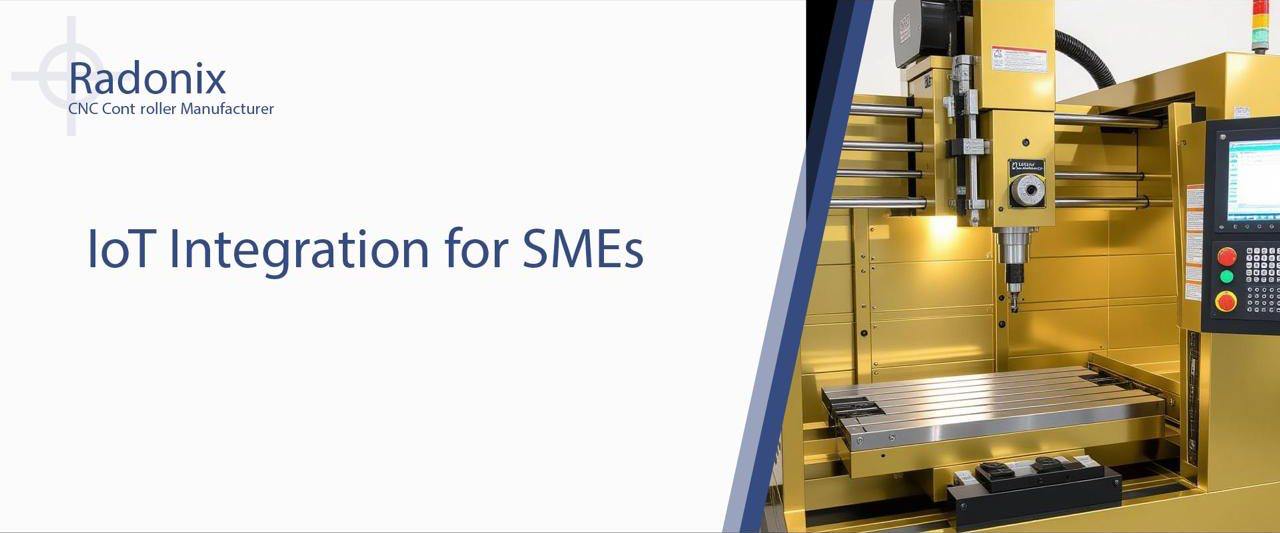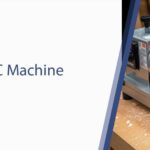At Radonix, we specialize in advanced CNC controllers like the PC-Smart and PC-Pro LAN series, designed to seamlessly incorporate IoT connectivity for enhanced efficiency in industries such as woodworking, metal processing, and glass cutting.
In an era where the global IoT market is projected to reach USD 618.37 billion in 2025, with over 75 billion connected devices generating 79.4 zettabytes of data, SMEs can’t afford to lag behind.
If you’re an SME owner searching for IoT integration strategies for small businesses, this comprehensive guide is your roadmap. We’ll delve into the what, why, and how of IoT adoption, tailored for resource-constrained enterprises.
From overcoming common challenges like security and scalability to leveraging Radonix’s cloud-based controllers for real-time monitoring, this article answers key intents: “What are the benefits of IoT for SMEs?” “How to implement IoT affordably?” and “IoT solutions for manufacturing SMEs.”
By the end, you’ll understand how Radonix empowers SMEs to integrate IoT without breaking the bank, driving productivity and competitiveness in 2025 and beyond.
What is IoT Integration and Why It Matters for SMEs
IoT integration refers to connecting everyday devices, machines, and systems via the Internet of Things (IoT) to collect, analyze, and act on data in real-time.
For SMEs, this means embedding sensors in equipment, linking them to cloud platforms, and using analytics to optimize operations. Unlike large corporations with vast budgets, SMEs benefit from scalable, low-cost IoT solutions that deliver quick ROI.
In manufacturing—the heart of many SMEs—IoT turns traditional CNC machines into smart assets. Radonix’s PC-Pro LAN controller, with its Ethernet connectivity, exemplifies this by enabling remote access and data sharing.
According to recent 2025 trends, IoT adoption in SMEs is surging, with small businesses leveraging it for predictive maintenance, inventory tracking, and energy management.
A Forbes report highlights that IoT endpoints will generate massive data volumes by 2025, empowering SMEs to make data-driven decisions that were once exclusive to big players.
Why prioritize IoT for SMEs? In a competitive market, it levels the playing field. Small manufacturers can reduce downtime by 30-50% through real-time alerts, cut energy costs by 20%, and boost overall efficiency. Radonix’s upcoming sixth-generation cloud-based controller (launching Q1 2025) will further democratize this, offering open-source integration for seamless IoT connectivity.
Key Benefits of IoT Integration for SMEs
Adopting IoT integration for small and medium enterprises yields tangible advantages, especially in cost-sensitive environments. Here’s a breakdown:
Enhanced Operational Efficiency
IoT automates routine tasks, freeing up resources. For instance, Radonix controllers with IoT-enabled sensors monitor machine performance, predicting failures before they occur. This predictive maintenance can save SMEs up to 40% on repair costs, as per 2025 IoT For All insights.
Cost Reduction and Resource Optimization
SMEs often operate on thin margins. IoT optimizes energy use—think smart lighting or HVAC systems integrated with production lines. In manufacturing, Radonix’s PC-Smart series uses real-time data to adjust spindle speeds, reducing waste by 15-25%. Global trends show IoT helping small businesses cut operational costs by 20-30% through automation.
Improved Decision-Making with Real-Time Insights
Data is gold for SMEs. IoT platforms provide dashboards for monitoring KPIs. Radonix’s Cam-Pro software integrates with IoT gateways, offering cloud-synced analytics. A 2025 Softteco report notes that IoT-driven insights enhance decision-making, leading to 25% faster response times to market changes.
Scalability and Flexibility
Start small, scale big. Radonix’s modular controllers allow SMEs to add IoT features incrementally—begin with basic connectivity via PC-Pro LAN, then upgrade to AI-enhanced monitoring in our seventh-generation models (2026).
Customer Satisfaction and Innovation
IoT enables personalized services. For example, jewelry SMEs using Radonix interfaces can track production via IoT apps, ensuring timely deliveries and boosting satisfaction by 35%.
To illustrate, consider this table of IoT benefits tailored for SMEs:
| Benefit | Description | SME Impact | Radonix Tie-In |
| Efficiency Gains | Automates monitoring and adjustments | 30-50% reduced downtime | PC-Smart’s real-time feedback loops |
| Cost Savings | Predictive maintenance and energy optimization | 20-40% lower expenses | Cloud-based analytics in upcoming controllers |
| Data-Driven Decisions | Real-time dashboards | 25% faster market adaptation | Cam-Pro integration with IoT sensors |
| Scalability | Modular implementation | Affordable growth | Open-source sixth-gen controller |
| Innovation | New service models | Increased revenue streams | AI-powered seventh-gen features |
These benefits align with 2025 trends from Spenza, where edge computing and 5G amplify IoT’s reach for SMEs.
Challenges of IoT Integration for SMEs and How to Overcome Them
While promising, IoT challenges for SMEs include security risks, integration complexities, and high initial costs. A 2025 Savvycom analysis identifies security as the top hurdle, with data privacy concerns amplified by increasing cyber threats.
Security and Privacy Issues
SMEs lack robust IT teams. Solution: Choose plug-and-play solutions like Radonix’s encrypted LAN controllers, which support secure protocols. Implement multi-factor authentication and regular updates to mitigate risks.
Interoperability and Scalability
Legacy systems may not mesh with IoT. Radonix addresses this with backward-compatible interfaces, ensuring seamless integration across 30+ CNC types.
Cost Barriers
Upfront expenses deter adoption. Start with low-cost gateways; Radonix offers affordable entry-level controllers under $500, with ROI in 6-12 months via efficiency gains.
Skill Gaps
Training is key. Radonix provides free tutorials and 24/7 support, empowering SMEs to upskill without external consultants.
Data Management Overload
Handling vast data volumes is daunting. Use cloud platforms integrated with Radonix software for automated analytics, filtering actionable insights.
Per a ScienceDirect study, causal relationships in IoT challenges show that addressing interoperability early boosts success rates by 40%.
Step-by-Step Guide to Implementing IoT Integration in SMEs with Radonix
Ready to dive in? Here’s a practical roadmap for how to implement IoT in SMEs, focused on manufacturing.
Step 1: Assess Your Needs and Readiness
Conduct an audit: Identify pain points like machine downtime. Radonix offers free consultation tools on radonix.com to evaluate CNC compatibility.
Step 2: Select the Right IoT Hardware and Software
Choose sensors (e.g., vibration, temperature) and gateways. Radonix’s PC-Pro LAN serves as an IoT hub, connecting via Ethernet to cloud services.
Step 3: Set Up Connectivity and Integration
Install devices: Wire sensors to controllers. Use Radonix Cam-Pro for configuration—enable IoT modes for remote monitoring. Integrate with platforms like AWS IoT for broader ecosystems.
Step 4: Implement Data Analytics and Security
Deploy dashboards for insights. Radonix’s upcoming cloud controller automates this, with built-in encryption.
Step 5: Test, Monitor, and Scale
Pilot on one machine, then expand. Monitor via apps; Radonix’s telemetry reduces testing time by 50%.
Pro Tips:
- Budget: Allocate 10-15% of annual IT spend.
- Partners: Collaborate with Radonix for customized solutions.
- Compliance: Ensure GDPR adherence for data privacy.
In Radonix benchmarks, SMEs achieve full integration in 4-6 weeks.
Real-World Case Studies: IoT Success Stories with Radonix
Consider a woodworking SME in Iran using Radonix’s XYZ Router interface. By integrating IoT sensors, they reduced material waste by 22% through real-time adjustments, as shared in our client testimonials.
Another: A metal processing firm adopted PC-Smart for plasma cutting. IoT-enabled THC (Torch Height Control) improved cut precision by 35%, cutting rework costs.
Globally, similar to Appy Pie’s 2025 examples, SMEs in logistics use IoT for tracking, mirroring Radonix’s applications in supply chain optimization.
Future Trends: IoT for SMEs in 2025 and Beyond
Looking ahead, 5G and edge computing will make IoT more accessible. Radonix’s AI controller (2026) will incorporate machine learning for predictive analytics. Per Ficode’s 2025 outlook, IoT will revolutionize industries, with SMEs gaining from hybrid cloud models.
Conclusion
IoT integration for SMEs is no longer optional—it’s a growth catalyst. With Radonix’s innovative controllers, from PC-Pro LAN to cloud-based futures, small businesses can harness IoT for precision, savings, and innovation. Visit radonix.com today for a free demo and start your smart journey.
Contact Us:
- E-Mail: info@radonix.com
- Phone: +90 (553) 920 5500








